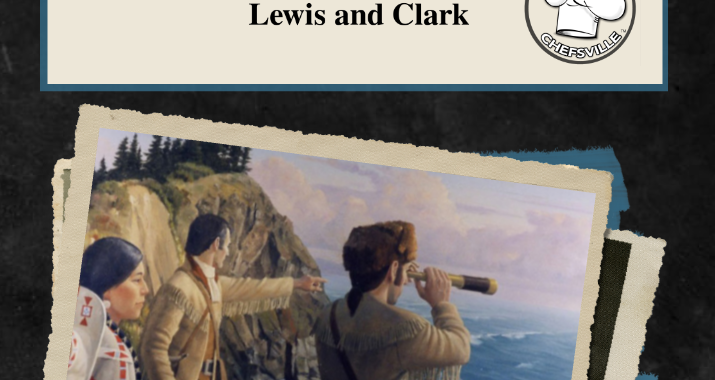Native American Indians Helped
The Mandans gave them buffalo meat and corn to survive the fierce North Dakota winter. The Hidatsas gave them information about the uncertain, unmapped route that awaited them along the Upper Missouri — describing mileposts they needed to watch for, down to the details of the sound of the Great Falls and a solitary eagle’s nest in a cottonwood tree that would assure the explorers they were on the right track. Without Shoshone and Salish horses, Lewis and Clark could not have crossed the Bitterroot Mountains. Without the salmon and camas roots offered freely by the Nez Perces, they would not have recovered from near-starvation after emerging from the mountains. The tribes of the arid Columbia Plateau provided them with much-needed food (dogs, mostly) on the expedition’s way out and back, when game was impossible to find and the men, despite their hunger, disdained the salmon teeming in the river. More food — and essential information — came from the Chinooks and the Clatsops along the Pacific Coast. The two captains understood from the start how crucial Native Americans were to their success. Lewis spent $559.50 — nearly one-quarter of the expedition’s entire congressional appropriation — on presents for the Indians: eight brass kettles, 130 rolls of tobacco, 500 brooches, 12 dozen pocket mirrors, 4,600 sewing needles, 33 pounds of tiny colored beads, silk ribbons and yards of bright-colored cloth, tomahawks that doubled as pipes, and much more. This doesn’t even count the boxes of Jefferson peace medals provided at no charge by the United States Mint. Clark certainly understood this point every time he sat down around a campfire with an Indian chief and an interpreter, and asked questions about the tributaries of the Missouri and Columbia — about the far-flung lands he would not get to see with his own eyes. Then, as the chief scratched lines in the dirt, with humps of clay to mark mountains, Clark would add that information to the new map of the West he was compiling for President Jefferson. Sacagawea, the one full-blood Indian on the expedition, admittedly has become nearly as famous as the two captains, and although her role often tends to be over-romanticized, her contribution to the Corps of Discovery’s achievements is indisputable. She was a mere teenager (and pregnant) when the captains met her at Fort Mandan in the late fall of 1804, but their journals show they immediately sensed that she could be the key to getting Shoshone horses once they reached her homeland in the Western mountains. Even after she helped obtain Shoshone horses, Sacagawea performed another vital role. “The sight of This Indian woman,” Clark wrote as they met tribe after tribe on the Columbia, “confirmed those people of our friendly intentions, as no woman ever accompanies a war party of Indians in this quarter.” The attention given to Sacagawea has tended to overshadow the fact that the explorers met — and relied just as heavily upon — many other Indians along the way. In the captains’ journals, those other Indians appear again and again — and not as abstractions but as real, living, breathing people. A chief named Shake Hand of the Yankton Sioux politely accepted his Jefferson peace medal from the captains, noting — and who knows if he meant this ironically, or even if they would have understood irony if they’d heard it — that he intended to put it with the peace medals he had already been given by the Spanish and British on behalf of the other “Great Fathers,” who, during the last quarter century, had been sending representatives up the lower Missouri like so many Fuller Brush salesmen. Arcawecharchi, another Yankton chief, struck a similar tone when the captains presented him with a 15-star flag. “I am a man and a chief of some note,” he told them with dignity on a hot summer day, after listening to their lengthy and occasionally condescending speech, each paragraph of which began with the word Children. “I am glad my grandfather has sent you to the people on this river,” he added, “and that he has given us a flag large and handsome, the shade of which we can sit under.” The equally proud Black Buffalo of the Teton Sioux, or Lakota, demonstrated remarkable diplomacy when he prevented a bloody battle that most likely would have resulted in the deaths of many of his tribe, as well as in the effective destruction of the expedition. Farther upriver, chiefs named Kakawissassa, Piahito, and Pocasse of the Arikaras patiently explained that they did not want any alcohol because it turned people into fools. During the flogging of the mutinous John Newman, they told the captains that they considered it uncivilized to whip a man in public. Just before the onset of the murderously harsh winter in North Dakota, the generous Sheheke of the Mandans told Lewis and Clark, “If we eat, you shall eat; if we starve, you must starve also.” Cameahwait of the Shoshones, whose people were starving, decided nevertheless to delay his tribe’s annual buffalo hunt in order to help the first white men his people had ever encountered. And on the far side of the Bitterroots, the expedition was fortunate to encounter Twisted Hair of the Nez Perces, whom Clark described as “a cheerful, sincere man,” and an old woman named Watkuweis. The explorers’ journals barely mention her, but according to tribal history, she is the one who persuaded her people to befriend rather than kill the weak and starving strangers from the East. Watkuweis told the Nez Perces, “Do them no hurt.”Source: //www.hcn.org/issues/280/14923
